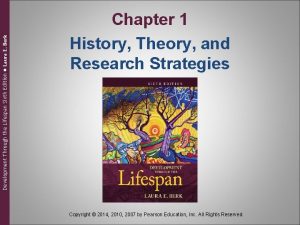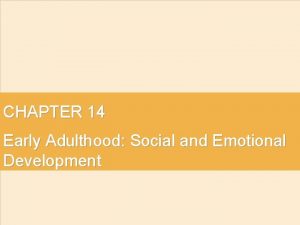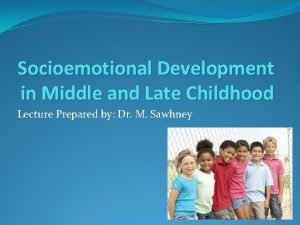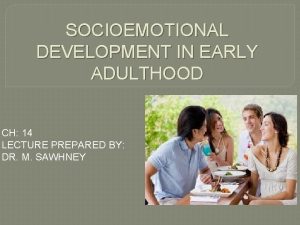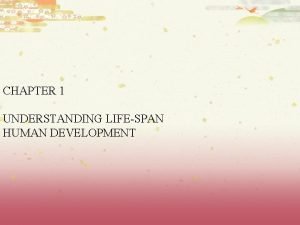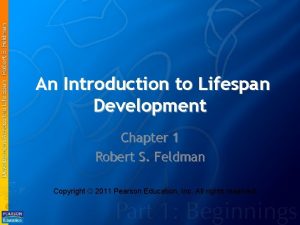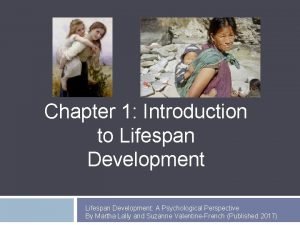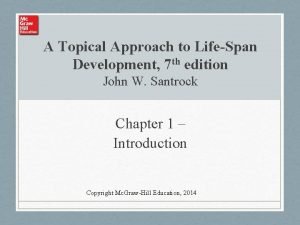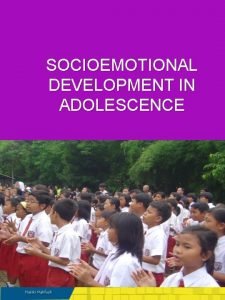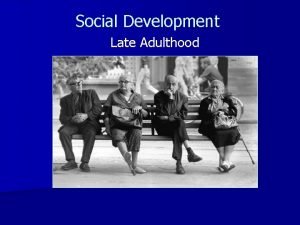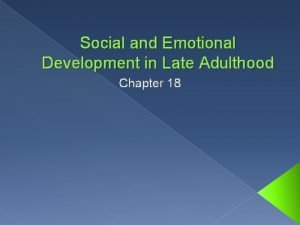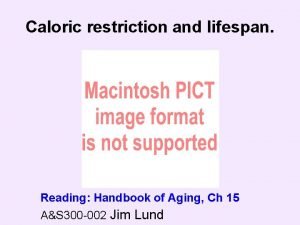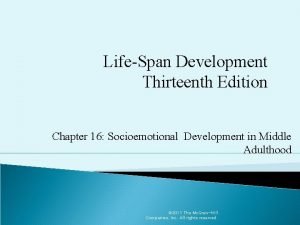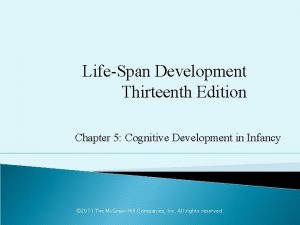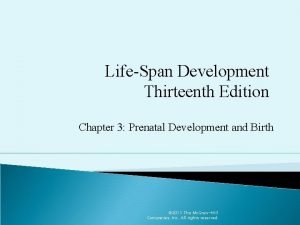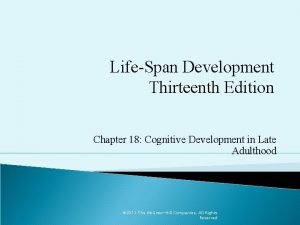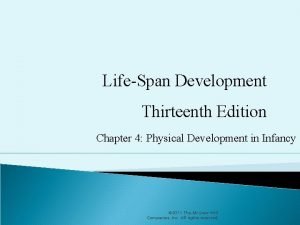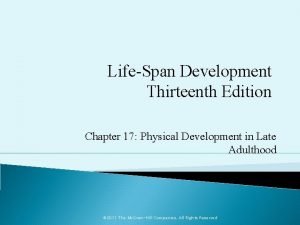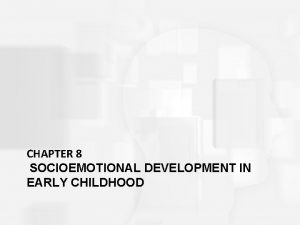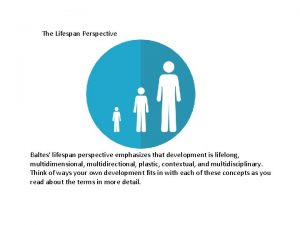LifeSpan Development Thirteenth Edition Chapter 12 Socioemotional Development































- Slides: 31

Life-Span Development Thirteenth Edition Chapter 12: Socioemotional Development in Adolescence © 2011 The Mc. Graw-Hill Companies, Inc. All rights reserved. 1

The Self, Identity, and Religious/Spiritual Development § Self Esteem § Self-Esteem is the overall way we evaluate ourselves § Controversy over whether or not self-esteem changes during adolescence or if there are gender differences in adolescents’ self-esteem § Narcissism – a self-centered and self-concerned approach toward others © 2011 The Mc. Graw-Hill Companies, Inc. All rights reserved. 2

The Self, Identity, and Religious/Spiritual Development Identity What is Identity – a self-portrait composed of many pieces such as: § § § Vocational/Career Political Religious Relationship Achievement, Intellectual § § § Sexual Cultural/Ethnic Interests Personality Physical © 2011 The Mc. Graw-Hill Companies, Inc. All rights reserved. 3

The Self, Identity, and Religious/Spiritual Development § Identity § Erikson’s View § Identity versus Identity Confusion: § Psychosocial Moratorium: the gap between childhood security and adult autonomy § Adolescents experiment with different roles and personalities § Adolescents who cope with conflicting identities emerge with a new sense of self § Adolescents who do not successfully resolve the identity crisis suffer identity confusion © 2011 The Mc. Graw-Hill Companies, Inc. All rights reserved. 4

The Self, Identity, and Religious/Spiritual Development § Identity § Developmental Changes § Four statuses of identity (Marcia, 1980, 1994) § Diffusion: individuals who have not yet experienced a crisis or made any commitments § Foreclosure: individuals who have made a commitment but not experienced a crisis § Moratorium: individuals who are in the midst of a crisis but whose commitments are absent or weak § Achievement: individuals who have undergone a crisis and made a commitment © 2011 The Mc. Graw-Hill Companies, Inc. All rights reserved. 5

The Self, Identity, and Religious/Spiritual Development Identity © 2011 The Mc. Graw-Hill Companies, Inc. All rights reserved. 6

The Self, Identity, and Religious/Spiritual Development § Identity § Emerging Adulthood and Beyond § Key changes in identity are more likely to take place in emerging adulthood than in adolescence § Identity does not remain stable throughout life § “MAMA”: repeated cycles of moratorium to achievement © 2011 The Mc. Graw-Hill Companies, Inc. All rights reserved. 7

The Self, Identity, and Religious/Spiritual Development § Identity § Ethnic Identity § An enduring aspect of the self that includes a sense of membership in an ethnic group and the attitudes and feelings related to that membership § Many adolescents develop a bicultural identity § Identify in some ways with their ethnic group and in other ways with the majority culture © 2011 The Mc. Graw-Hill Companies, Inc. All rights reserved. 8

The Self, Identity, and Religious/Spiritual Development § Religious and Spiritual Development § Downtrend in religious interest among adolescents has occurred in the 21 st century § Religious and identity development § Cognitive Development and Religion in Adolescence § Increase in abstract thinking lets adolescents consider various ideas about religious and spiritual concepts § The Positive Role of Religion in Adolescents’ Lives © 2011 The Mc. Graw-Hill Companies, Inc. All rights reserved. 9

Families § Parental Monitoring § Should supervise adolescents’ choice of social settings, activities, and friends, as well as their academic efforts § Authoritative parenting - parents encourage adolescents to be independent but still place limits and controls on their actions © 2011 The Mc. Graw-Hill Companies, Inc. All rights reserved. 10

Families § Autonomy and Attachment § Parents must weigh needs for autonomy and control, independence and connection § The Push For Autonomy § May puzzle and anger many parents § Adolescents’ ability to attain autonomy and gain control over their behavior is acquired through appropriate adult reactions to their desire for control § Boys are often given more independence than girls © 2011 The Mc. Graw-Hill Companies, Inc. All rights reserved. 11

Families § Role of Attachment: § Secure attachment is an important concept in adolescents’ relationship with their parents § Balancing Freedom and Control: § Adolescents still need to stay connected to families © 2011 The Mc. Graw-Hill Companies, Inc. All rights reserved. 12

Families § Parent–Adolescent Conflict § Parent–adolescent conflict increases in early adolescence but not to tumultuous proportions § Disagreements may serve a positive developmental function § New model emphasizes that parents serve as important attachment figures and support systems © 2011 The Mc. Graw-Hill Companies, Inc. All rights reserved. 13

Peers § Friendships § Most teens prefer a smaller number of friendships that are more intense and more intimate § Friends become increasingly important in meeting social needs § Gossip about peers can lead to relational aggression § Characteristics of friends have an important influence § Friends’ grade-point average is a consistent predictor of positive school achievement © 2011 The Mc. Graw-Hill Companies, Inc. All rights reserved. 14

Peers © 2011 The Mc. Graw-Hill Companies, Inc. All rights reserved. 15

Peers § Peer Groups § Peer Pressure § Young adolescents conform more to peer standards than children do § Adolescents with low self-esteem and high social anxiety are most likely to conform to peers © 2011 The Mc. Graw-Hill Companies, Inc. All rights reserved. 16

Peers § Peer Groups § Cliques and Crowds § Cliques: small groups (2 to 12 individuals), typically of the same sex and about the same age § Engage in similar activities § Crowds: larger than cliques and less personal § Members are based on reputation § May not spend much time together © 2011 The Mc. Graw-Hill Companies, Inc. All rights reserved. 17

Peers § Dating and Romantic Relationships § Developmental Changes in Dating and Romantic Relationships § Three stages § Entry into romantic attractions and affiliations at about 11 to 13 years of age § Exploring romantic relationships at approximately 14 to 16 years of age § Consolidating dyadic romantic bonds at about 17 to 19 years of age © 2011 The Mc. Graw-Hill Companies, Inc. All rights reserved. 18

Peers § Dating and Romantic Relationships § Gay Male and Lesbian Youth § Many date other-sex peers, which can help clarify their sexual orientation or disguise it from others § Sociocultural Contexts and Dating § Differences in dating patterns among ethnic groups in the U. S. § Values, beliefs, and traditions often dictate the age at which dating begins © 2011 The Mc. Graw-Hill Companies, Inc. All rights reserved. 19

Peers § Dating and Romantic Relationships § Dating and Adjustment § Researchers have now linked dating and romantic relationships in adolescence with measures of how well-adjusted adolescents are © 2011 The Mc. Graw-Hill Companies, Inc. All rights reserved. 20

Culture and Adolescent Development § Cross-Cultural Comparisons § Traditions and Changes in Adolescence around the Globe § Health § Gender § Family § Peers § Time Allocation to Different Activities § Rites of Passage © 2011 The Mc. Graw-Hill Companies, Inc. All rights reserved. 21

Culture and Adolescent Development § Ethnicity § Immigration § High rates of immigration are contributing to the growth of ethnic minorities in the U. S. § Immigrants often experience stressors uncommon to longtime residents § Ethnicity and Socioeconomic Status § Ethnicity and socioeconomic status can interact in ways that exaggerate the influence of ethnicity © 2011 The Mc. Graw-Hill Companies, Inc. All rights reserved. 22

Culture and Adolescent Development § The Media § Media Use § Youth today are surrounded by the media; 6. 5 hours a day § The use of technology is the dramatic increase in media § Difficulty in concentrating on driving while text messaging § Television viewing and video-game playing peak in early adolescence and then begin to decline © 2011 The Mc. Graw-Hill Companies, Inc. All rights reserved. 23

Culture and Adolescent Development § The Media § The On-Line Lives of Adolescents § Youth throughout the world are increasingly using the Internet § One of three adolescents self-disclose better online than in person § Special concerns have emerged about children’s and adolescents’ access to information on the Internet § The social environment of adolescents and emerging adults on the Internet is a concern © 2011 The Mc. Graw-Hill Companies, Inc. All rights reserved. 24

Adolescent Problems § Juvenile Delinquency § Juvenile Delinquent: an adolescent who breaks the law or engages in behavior that is considered illegal § Males more likely to engage in delinquency than females § Rates among minority groups and lower-SES youth are especially high © 2011 The Mc. Graw-Hill Companies, Inc. All rights reserved. 25

Adolescent Problems § Juvenile Delinquency § Causes of Delinquency § Lower class culture § Parents less skilled in discouraging antisocial behavior § Siblings and delinquent peers © 2011 The Mc. Graw-Hill Companies, Inc. All rights reserved. 26

Adolescent Problems § Depression and Suicide § Depression § Rates of ever experiencing major depressive disorder range from 15 to 20 percent for adolescents § Certain family factors place adolescents at risk for developing depression § Poor peer relationships are associated with adolescent depression § Depressed adolescents recovered faster when they took an antidepressant and received cognitive behavior therapy than when they received either treatment alone © 2011 The Mc. Graw-Hill Companies, Inc. All rights reserved. 27

Adolescent Problems § Depression and Suicide § Suicide is the 3 rd leading cause of death in 10 - to 19 -year-olds § Far more adolescents contemplate or attempt it unsuccessfully than actually commit it § Females are more likely to attempt suicide, but males are more likely to succeed © 2011 The Mc. Graw-Hill Companies, Inc. All rights reserved. 28

Adolescent Problems § Depression and Suicide § Other Risk Factors § History of family instability and unhappiness § Lack of supportive friendships § Cultural contexts § Genetic factors § Depressive symptoms © 2011 The Mc. Graw-Hill Companies, Inc. All rights reserved. 29

The Interrelation of Problems and Successful Prevention/Intervention Programs § Four problems that affect the most adolescents: § Drug abuse § Juvenile delinquency § Sexual problems § School-related problems © 2011 The Mc. Graw-Hill Companies, Inc. All rights reserved. 30

The Interrelation of Problems and Successful Prevention/Intervention Programs § Successful Intervention Programs Include: § Intensive individualized attention § Community-wide multiagency collaborative approaches § Early identification and intervention © 2011 The Mc. Graw-Hill Companies, Inc. All rights reserved. 31
 Development through the lifespan 6th edition
Development through the lifespan 6th edition Lifespan development third edition
Lifespan development third edition Lifespan development third edition
Lifespan development third edition Experiencing the lifespan 4th edition
Experiencing the lifespan 4th edition Socioemotional development in infancy
Socioemotional development in infancy Social and emotional development in late adulthood
Social and emotional development in late adulthood Socioemotional development in early adulthood
Socioemotional development in early adulthood Socioemotional development in middle and late childhood
Socioemotional development in middle and late childhood Early adulthood socioemotional development
Early adulthood socioemotional development Emotional and social development in middle adulthood
Emotional and social development in middle adulthood Openstax
Openstax Development takes place gradually
Development takes place gradually Exploring lifespan development chapter 1
Exploring lifespan development chapter 1 Sociocultural graded influences
Sociocultural graded influences Lifespan development a psychological perspective
Lifespan development a psychological perspective A topical approach to lifespan development
A topical approach to lifespan development Guidance counselling and lifespan development
Guidance counselling and lifespan development Socioemotional maintenance definition
Socioemotional maintenance definition It is a self-portrait composed of many pieces
It is a self-portrait composed of many pieces Disengagement theory
Disengagement theory Robert peck's stages of psychological development
Robert peck's stages of psychological development Using mis 10th edition
Using mis 10th edition Mis
Mis What is a leopards life cycle
What is a leopards life cycle What does a gulper eel eat
What does a gulper eel eat Petit four sec
Petit four sec Splendour beetle
Splendour beetle Honeybee lifespan
Honeybee lifespan Juan ponce de leon nationality
Juan ponce de leon nationality Henry hudson lifespan
Henry hudson lifespan Lifespan of every animal
Lifespan of every animal The developing person through the lifespan
The developing person through the lifespan
